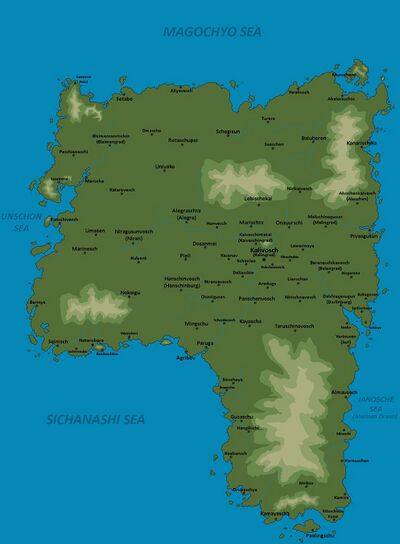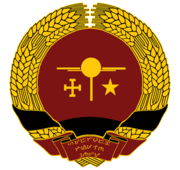Janpia
This article is incomplete because it is pending further input from participants, or it is a work-in-progress by one author. Please comment on this article's talk page to share your input, comments and questions. Note: To contribute to this article, you may need to seek help from the author(s) of this page. |
Janpian Union of Revolutionary States Simplified: Janosche Revolutsiya Sumosch Unschon Traditional: Janosche no Unschon o Rasteruschen Sumosch | |
|---|---|
| Motto: Hardwork, Unity, Discipline | |
| Anthem: Forwards Janpians (Instrumental) | |
 Map of the Janpian Home Islands | |
| Capital and largest city | Kalingrad City |
| Official languages | Janpian, English |
| Demonym(s) | Janpians |
| Government | Revolutionary Syndicalist Union |
| Annie Natya Anya | |
| Legislature | Union of Party Members Committee |
| History | |
| 1st Era | |
| 2nd Era | |
| 3rd Era | |
| 4th Era | |
| 5th Era | |
| Population | |
• 2024 estimate | 777,201,536 |
• 1980 census | 542,211,894 |
| GDP (nominal) | 2024 estimate |
• Total | 17.3 Trillion NSD |
• Per capita | 22,264.44 NSD |
| Gini (2024) | medium |
| HDI (2024) | high |
| Currency | Petoschki ₱ |
| Time zone | UTC+1 ( Eastern Janpian Time, Western Janpian Time) |
| Date format | mm.dd.yyyy |
| Driving side | right |
| Calling code | +7 |
| Internet TLD | .jur |
The Janpian Union, officially known as the Janpian Union of Revolutionary States (JURS) or the United Revolutionary States of Janpia, is an island nation located in the East Hiakemirian Region of Esvanovia, bounded by the Janosche Ocean at the east, the Unschon Group of Islands at its west, the Sea of Sichanashi at its south, and the Sea of Magochyo to its north. Consisting of up to 6,354 islands, the Janpian archipelago has two main geographical divisions, with the west being the Unschon Island Group comprised of smaller islands, and the Janpian Home Islands, which include the mainland as well as its nearby island peripheries. It shares maritime borders with Atkemri to the west and the Neo-Korea at its Southwest. Janpia is a highly homogenous ethnic society with around 97.5% being Janosche, and the remaining for the visitors or Unschon Islands ethnic groups. Kalingrad is the largest city as well as its capital, with Darlinburg City, a former capital of the Janpian Empire, being regarded as its sole "sister" capital.
The Janpian Union, particularly the Janpian Union of Government Workers' Party (JUGWP), is considered as the successor of the Janpian Empire as well as the various pan-leftist party-factions during the Janpian Civil War. This came into conclusion after the establishment of the Janpian Union of Revolutionary States after 15 years of struggle, with all the warring leftist parties and factions uniting for a single vanguard party. Consequently, the former Imperial Janpian colonies of Unschon Islands came into integration to the Janpian core territories, with all the people in colonial domains being given the same rights similar to the ones in the mainland. Currently, the Janpian Union can be described as a Party-State with all the necessary state organs and political establishments functioning within the Party itself, which acts more like the state.
Based on the Party's Revolutionary Ideals, the original political organizations and among others within the JUGWP are developed with the sole goal of spreading the Revolution abroad through armed means. Among the examples are the position titles such as the "People's Marshal", which connotates the people and the military under their joint command. As the Party stabilized, other functions sprung out as well, which eventually leads to the creation of the Janpian Revolutionary Constitution
The revolution is officially not yet over as the world is not enlightened by the revolutionary ideals. The goal of the revolution is to bring true peace, stability, equality and harmony to all nations through leftist ideals by destroying Janpian enemies and counter revolutionaries in any manner. If all of this is finished, the Party, along with the rest, will dissolve itself, creating a stateless, classless society of communes.
Etymology
The term Janpia came from the name of a 1st Era warlord, Janoschpe III. He is responsible for uniting all the tribes and kingdoms of Janpia in a bloody campaign, which eventually united the Janpian mainland and forming an early national identity. The followers of Janoschpe III were later called Janosche, also known as Janpians.
Another term for Janpia is "Dabun Javosch." When translated to Janpian, it literally means "the land of the dead emperors", given that a lot of places were named after the death places of kings, emperors, or their lineage.
One of the examples is when King Magochyo of Munschen escaped to the northern sea in order to evade Janoschpe's army. He was never seen or found ever again. Thus, the sea where he escaped is called the Sea of Magochyo.
Another example is the term "Janpia" or "Janosche," which means followers of King Janoschpe III. For many centuries, Janpia was ruled by the Janoschpe family, who had direct lineage to King Janoschpe III. They even managed to remain as "Emperors" during the colonial years of the 2nd Era. However, during the 4th era, the entire lineage of Emperor Janoschpe III and its followers were brutally killed during the civil war.
History
Main article: Janpian History
In accordance to the Schonghue belief, ancient Janpian historians have set the basis of dividing the history of Janpia to the current Edict of Heavens, and counting the years and time depending on to it. The idea is that the rules of society varies per eras as granted by the higher edict, which grants and legitimize the rule or authority of a certain regime or dynasty, enforcing the mystical idea of myriad rule. Given how the current Janpian years are counted on eras, modern Janpian historians still use the edicts as a way to determine the exact date of an historic event, and to who's rule was it actually placed
1st Era (Schonghuescha Era)
TBA
2nd Era (Marquesan Colonial Era)
TBA
3rd Era (Imperial Rebirth)
TBA
4th Era (Janpian Civil War)
TBA
5th Era (Contemporary)
TBA
Geography
Janpia is comprised of 6,354 islands, both habited and uninhabited, which are divided on to two main geographical divisions. The Janpian Home Islands, the largest of the two, are mainly made up of plains and forests which takes up the 82% of the island's topography, with the rest reserved for the mountain ranges. The other, the Unschon Island Group, are a small western group of volcanic islands separated from the peripheries of the Janpian Mainland. These islands are primarily habitable and has a different climate from the mainland due to its topography and general location. Its total landmass is certainly much smaller than the Janpian Home Islands
The Janpian Home Islands was formed over 450 million years ago due to the subduction of the Marinan plates with the Hiakemirian plates, causing magma to rise which now solidified itself as the Janpian archipelago. Subsequently, the Unschon Island Group was also formed along the subduction lines, which created volcanic activity, forming the current islands today. Janpia is often prone to earthquakes, tsunamis, or volcanic eruptions, given that it is located along the Marinan Ring of Fire and home of more than 108 active volcanoes on both land and underwater features. This makes Janpia one of the highest in terms of natural disaster risk, as proven by the 1923 Kayacha Earthquake which killed over 110,000 people, or the 1986 Noterburg Earthquake which also caused a tsunami.
The Great Janpian Middle Plains covers the entire extent between the east and west Janpian coasts, with the midlands mostly filled with rivers and estuaries making the land fertile, arable, and habitable. Historically, the middle Janpian plains have been the central cradle of Schonghue civilizations and currently where the most population resides. The plains also offer a safe distance from the current known active volcanoes as well, making it a viable choice to build and thrive. Lake Truschina is an ancient fresh water lake that is also the largest in Janpia.
Climate
TBA
Biodiversity
TBA

